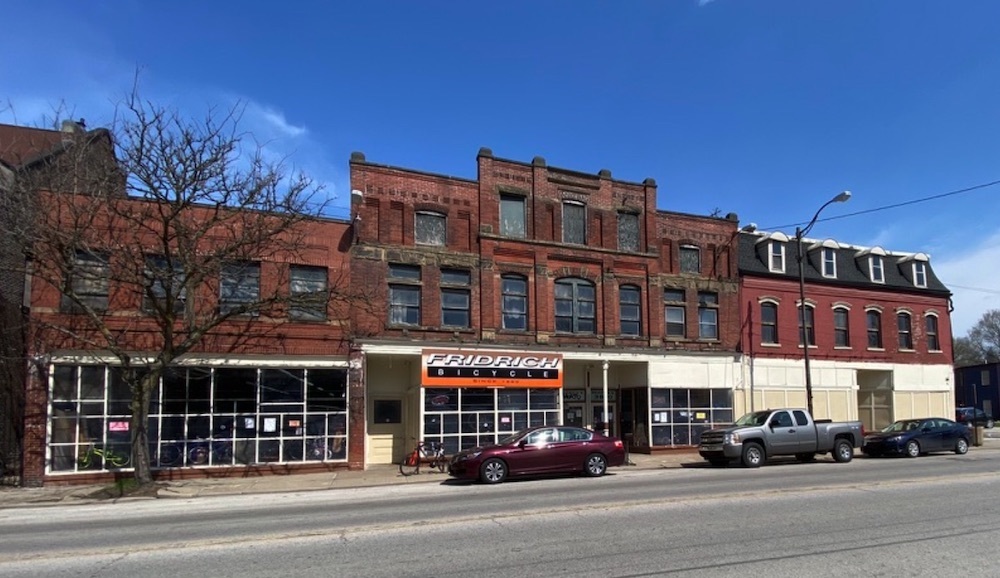
Fridrich Bicycle is Cleveland's oldest retail bicycle shop and is among the oldest in the United States. The Fridrich family has been selling bicycles in Cleveland for well over 100 years. The family's roots in the Lorain Avenue Commercial Historic District, however, extend even deeper than that.
As in many other American families, the Fridrich family story begins with an immigrant. In 1847, 36 year-old Joseph Friedrich, the unmarried son of a restaurant owner in Pirkensee, Bavaria, emigrated from his homeland. At the time, revolution and war in central Europe were pushing large numbers of ethnic Germans out of their principalities which became parts of a unified German state in 1871. Many immigrated to the United States, and to Cleveland, then a young, but growing, industrial city in the Midwest. Friedrich--who would later change his surname to "Fridrich"--may have traveled directly to Cleveland from Europe, but there is no record of his presence until May 1853 when County records reveal that he married Margarete Schaefer, also a German immigrant.
Margarete Schaefer Friedrich was the mother of three young boys--John, Anton and August Schmidt--all under the age of eight. When he married her, Joseph Friedrich became a father to all of them. Over the course of the next ten years, he worked as a laborer--for at least some of that time employed by the Cleveland and Erie Railroad. Margarete gave birth to three more boys, Joseph W., George, and William Friedrich. In 1863, the year their youngest son William was born, the Friedrich family was residing in a house near the intersection of Old River and Mulberry Streets on the West Bank of the Flats. The surrounding neighborhood was fast developing into an Irish-American enclave which became known as the Triangle, later shortened to "the Angle," and today nostalgically referred to by the Cleveland Irish community as "the Old Angle."
In 1864, the Friedrichs moved from the Angle about a mile south to a growing and predominantly German-American neighborhood that was centered around Lorain Street (Avenue) and located primarily west of Pearl (West 25th) Street. Joseph purchased a new house on Branch (later renamed China, then Elvira and finally West 37th), a street south of Lorain and just west of Willet (Fulton) Road. It was one of several streets in a new residential subdivision platted in 1860 by real estate developers John H. Sargent and Thomas Dixon. Sargent & Dixon's subdivision was just one of a number built north and south of Lorain Street in the 1850s and 1860s that together grew into a neighborhood that was centered around a commercial corridor on Lorain Street.
Growing up in this neighborhood, the Schmidt and Friedrich boys would have had ample opportunity to explore Lorain Street, located less than a quarter mile from their doorstep. When the family first arrived, most buildings on Lorain were one or two stories and made of wood. Later, by the 1880s, many of the earlier era buildings had been razed and replaced by taller, more ornate buildings often built of brick. When the boys made their first trips up to the corner of Mechanic (West 38th) Street and Lorain, possibly the first building that would catch their eyes was the livery and stable of Andrew Steinmetz which was built circa 1871. It was located almost directly across Lorain from Mechanic Street, and it clearly stood out from other nearby buildings because of its unusual mansard roof and because of the constant stream of horses, wagons and carriages going into or out of the building.
Over the years as they grew up in their house on Branch which was renamed China Street in 1873, the Schmidt and Friedrich boys likely made many trips up to the corner and then up or down Lorain Street. By 1880, this corridor was lined with commercial buildings that stretched westward from near Columbus Road almost all the way to Gordon Avenue (West 65th Street) near Cleveland's border with the suburb of West Cleveland. Some of those trips likely took them to the Pearl Street Market on the northwest corner of Lorain and Pearl (West 25th) Street, just a half mile east of Mechanic Street. When the Friedrich family moved into the neighborhood in 1864, there was an open-air market on that corner that was known as the West Side Market. Four years later, the City of Cleveland built a one-story wooden market house on the site which it named after nearby Pearl Street. (Forty-four years later in 1912, the market house that we know today as the West Side Market would open across the street, and the Pearl Street Market would shortly afterwards be razed.)
Walking or riding to the Market, the Schmidt and Friedrich boys would have passed a number of thriving shops in the second half of the nineteenth century that became well-known to them, like Julius Grothe's cabinet shop at 265 (today, 3704) Lorain, John Kraus's boots and shoe shop at 257 (3622) Lorain, the Koblenzer family's butcher shop at 246 (3613) Lorain, and Heidenger's Bakery at 234 (3601) Lorain, just to name a few. As they crossed Fulton Road, they would also have noted the rest of the nearly two dozen saloons that dotted the corners of Lorain from Mechanic Street to the Market, some sharing space with early grocery stores, others located in boarding houses. The boys would take in all the sights, sounds and smells of the commercial businesses of Lorain Street, including the pungent aromas from the Dahlheimer cigar and tobacco factory and retail shop at 199 (3228) Lorain. In 1875, it was purchased by new owner Charles Sauer who, some two decades later, would build a new and larger factory and retail shop on the premises, one still standing today and recently renovated and restored. As the boys neared the Pearl Street Market, they might have noticed the millinery shop of Matilda and Julia Chubb at 96 (2615) Lorain, diagonally across the street. The two sisters operated their retail business on the southwest corner of McLean (West 26th) Street and Lorain for nearly 20 years in the second half of the nineteenth century before retiring and moving to Lakewood. As the boys passed the store, they may have turned their heads to better admire a fashionably dressed young woman leaving the Chubb sisters' store with a new hat atop her head.
The Schmidt and Friedrich boys were undoubtedly influenced by interactions with the Lorain Street commercial corridor like those imagined above. While the two oldest Schmidt boys worked in traditional trades (one becoming a stone cutter and the other a bookkeeper), the younger four, after they became old enough, by nineteenth-century standards, to work for a living, all started new retail businesses on Lorain Street. This development within the second generation of the Fridrich family living in America would lead not only to the 1909 establishment of Fridrich Bicycle, but also to Fridrich Moving and Storage Co., another Fridrich family business that was founded by youngest brother William in 1915 and which has, like the bicycle shop, now operated in the Cleveland area for more than a century.
Fridrich Bicycle grew out of an early business partnership between August Schmidt, the youngest of the Schmitt brothers, and Joseph W. Friedrich, the oldest of the Friedriches. In 1884, 34 year-old Schmidt, who by this time was spelling his last name "Schmitt," and 26 year-old Friedrich (whose immigrant father, a short time before his death in 1888, would change the spelling of their family's last name to "Fridrich") started a retail coal business under the name of "Schmitt and Friedrich." Originally operating out of the family house at 19 China (2000 West 37th) Street, the two moved their business in 1885 into a storefront at 840 (3817) Lorain Street. Why they decided to start a retail coal business is unknown, but it may have been prompted by contacts their father developed while working for the Cleveland and Erie Railroad. Meanwhile, the two youngest Friedrich boys, William and George, had also pooled their resources together and, in 1891, started a retail flour and feed business up the street from their older brothers' retail coal store at 924 (4209) Lorain.)
After operating their retail coal store together for 15 years, August Schmitt and Joseph W. Fridrich closed it in 1900, with each starting new retail coal businesses in their individual names. While it is unknown why they ended their partnership, it may have been related to their different family statuses. Joseph W. Fridrich had married in 1881 and, by 1900, had two sons--one of whom, Joseph Aloysius Fridrich, was 17 years old and already working in the family coal business. August Schmitt, on the other hand, though eight years older than his brother, had not married until 1891 and had children who in 1900 were just 3 and 7 years old. Schmitt operated his new business out of a store at 750 (3207) Lorain, while Fridrich took over the storefront of their former partnership business at 840 Lorain.
While August Schmitt's new business was apparently successful--he operated it until his retirement in 1915, Joseph W. Fridrich's appeared to have been less so, as he faced the challenge of bringing two sons into the business. In 1902, he opened a flour and feed store at 842 (3821) Lorain, right next door to his retail coal store, but that business closed by 1904. He then formed a new partnership in the retail coal business with August Schmitt and his younger brother William Fridrich, but both August and William appear to have withdrawn from this association by 1907. Joseph might have attempted other changes to his business model had not a new business opportunity suddenly come his way in 1908. After his flour and feed store at 842 Lorain had closed in 1904, that storefront had been rented to a Walter J. Meyers, who opened a retail bicycle store there that same year. Sometime in late 1908 or early 1909, however, Meyers closed his shop. It is likely that Joseph's younger son, Alphonse, who, probably more so than his father, was aware of the bicycle "craze" going on in the United States in the early twentieth century, successfully lobbied his father to take over Meyer's bicycle shop. It was the beginning of Fridrich Bicycle and the end of Joseph Fridrich's retail coal shop, which closed the same year.
While Alphonse Fridrich was the first manager of Fridrich Bicycle, the business was later largely operated by Joseph W. Fridrich and his older son Joseph Aloysius. The Fridrich family continued to lease space for their shop at 3821 Lorain until 1915 when they purchased the building. In 1919, they added a retail auto parts business to their store and changed the name of the business to Fridrich Bicycle and Auto Supply Co. In 1925, as the result of the successful growth of these two businesses, the Fridrich family purchased a building across Lorain Avenue which had originally been Andrew Steinmetz's livery and stable. It must have given Joseph W. Fridrich some pause the day he vacated the storefront at 3821 Lorain and moved the business across the street into the historic building which had likely captured his imagination as a child.
Seven years later, in 1932, Joseph W. Fridrich died and a new era in the family began when his son Joseph Aloysius took over operation of the store. He was helped by his son Joseph J. who had dropped out of high school to work in the family business. Continuing to thrive on Lorain Avenue, even in the wake of the Great Depression, Fridrich Bicycle and Auto Supply expanded again in 1942, purchasing the three-story Schenck Building at 3806-3808 Lorain. The business's address for its combined retail operations in the two buildings would soon be changed to simply 3800 Lorain. In 1947, when he was just 64 years old, Joseph Aloysius Fridrich died and this ushered in yet another new era for the family business.
Joseph J. Fridrich, known in the family as "J.J.," took over the operations of the store. He is remembered by members of the Fridrich family today for the "Cadillac" bicycles which he and staff built in the store's basement, and which he passionately promoted as the store's owner and manager. J.J. Fridrich also built a new building on Lorain Avenue to the west and adjacent to the Schenck Building, which soon became known in the family as "Schwinn Hall," because its first floor was used to display the company's inventory of Schwinn bicycles. In the 1960s, he made the decision to close the retail auto parts business and to concentrate exclusively on selling bicycles of all types. In 1966, the name of the company was accordingly changed to Fridrich Bicycle, Inc.
J. J. Fridrich owned and operated Fridrich Bicycle until his death in 1992. According to an article appearing in the Plain Dealer on April 14, 1992, when the store closed for a day in his memory, it was the first time it had closed on a day other than Christmas in the memory of anyone then working at the store. Since 1992, the store has been owned and the business operated by J.J's son, Charles "Chuck" Fridrich. Day-to-day operations are handled by Jane Alley, the store's general manager, and a staff of nine employees. Cleveland's oldest retail bicycle store remains an important business in the Lorain Avenue Commercial Historic District, as well as the custodian of two of that District's most historic buildings.
Images

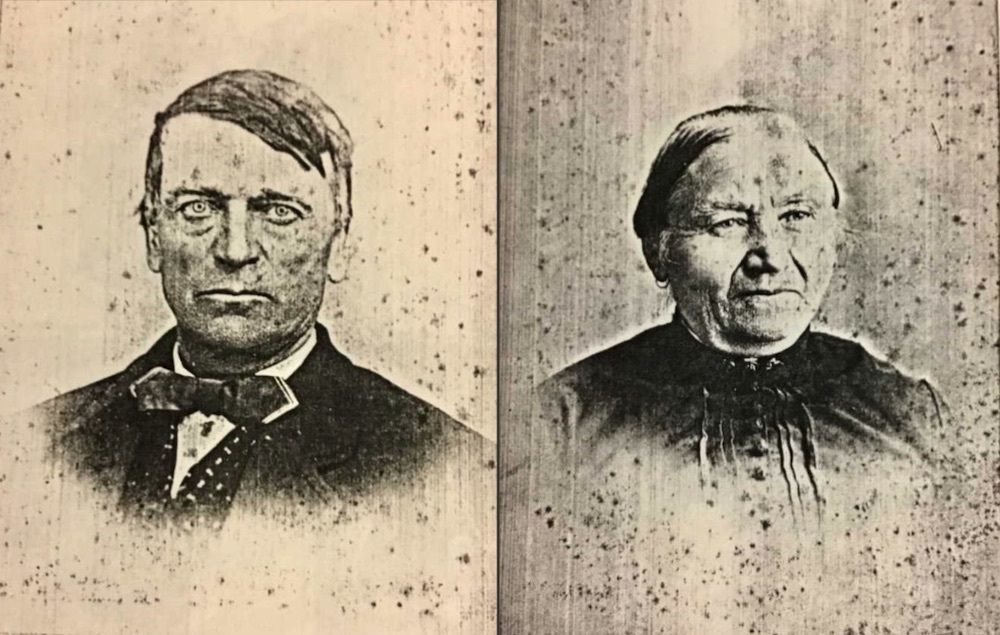
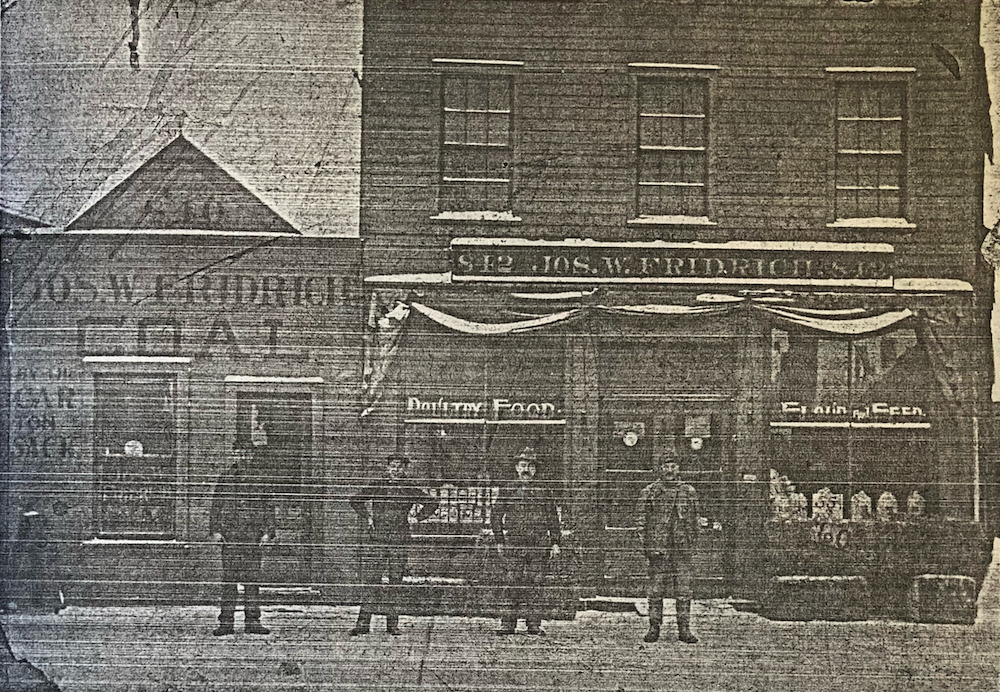



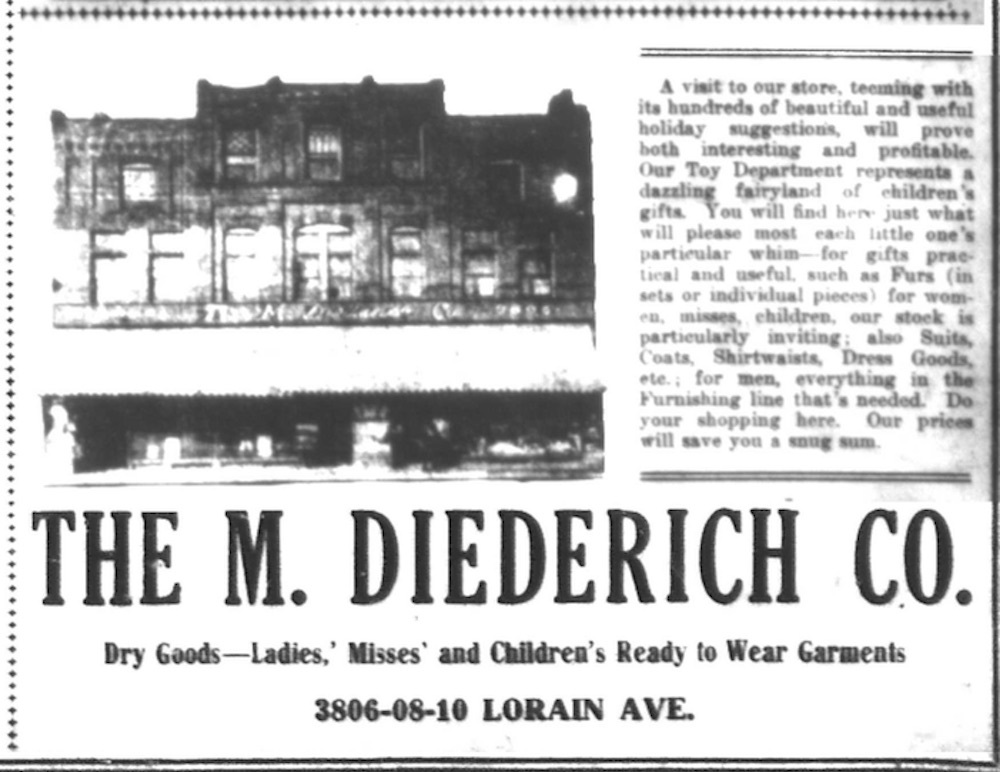
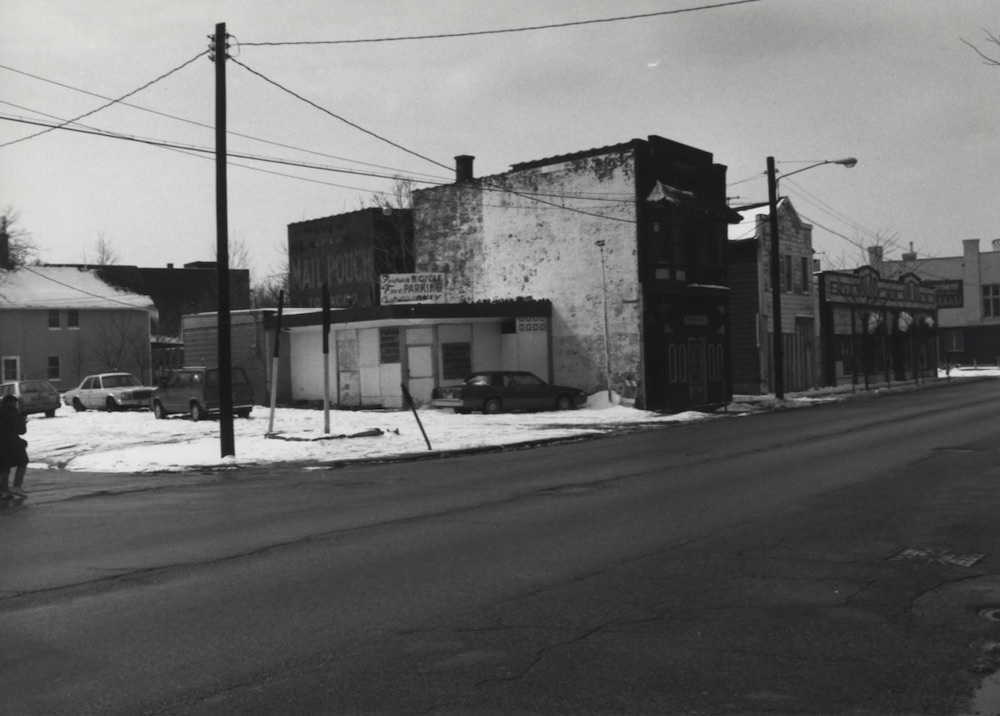

This undated photo of Fridrich Bicycle Store, likely taken after the business moved across the street into the former Steinmetz Livery and Stable Building, shows Fridrich employees repairing bicycles. Source: Nancy Todd Paris, a great-great granddaughter of Joseph and Margarete Schaefer Fridrich.




